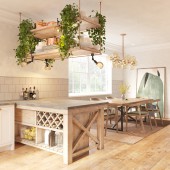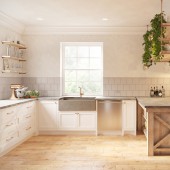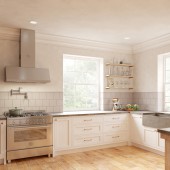
| THE AWARD |
| CATEGORIES |
| REGISTRATION |
| SUBMIT YOUR WORK |
| ENTRY INSTRUCTIONS |
| TERMS & CONDITIONS |
| PUBLICATIONS |
| DATES & FEES |
| METHODOLOGY |
| CONTACT |
| WINNERS |
| PRESS ROOM |
| GET INVOLVED |
| DESIGN PRIZE |
| DESIGN STORE |
| THE AWARD | JURY | CATEGORIES | REGISTRATION | PRESS | WINNERS | PUBLICATIONS | ENTRY INSTRUCTIONS |
Scarsdale Nouveau Residential Remodel by Artem Kropovinsky |
Home > Winners > Design #154882 >Interview |
 |
|
FS: What is the main principle, idea and inspiration behind your design?
AK: The main principle behind my design is sustainability, aligned with the Urban Harmony concept I developed. The idea was to use natural materials and neutral colors to create a timeless, earthy aesthetic. The inspiration comes from nature itself, aiming to achieve a look that is not sterile but rather organic and specifically tailored to people’s needs.
FS: What has been your main focus in designing this work? Especially what did you want to achieve?
AK: The main focus was to demonstrate how natural materials can be effectively used in interior design to create a harmonious and timeless environment. I wanted to achieve a design that would remain relevant for many years, reflecting the client’s preferences and requirements without following short-term trends.
FS: What are your future plans for this award winning design?
AK: Future plans include promoting the Urban Harmony concept to a wider audience. By submitting this design to competitions and showcasing it, I hope to inspire other designers to adopt sustainable practices and integrate natural materials into their projects.
FS: How long did it take you to design this particular concept?
AK: It took around six months for my company to develop this concept and about a year for its implementation.
FS: Why did you design this particular concept? Was this design commissioned or did you decide to pursuit an inspiration?
AK: This design was driven by inspiration. The goal was to create something unique that would perfectly fit the client’s needs while aligning with my passion for sustainability and natural aesthetics.
FS: Is your design being produced or used by another company, or do you plan to sell or lease the production rights or do you intent to produce your work yourself?
AK: This design is produced by my company, and all rights are retained by us. I intend to maintain control over its production to ensure that the integrity of the concept is preserved.
FS: What made you design this particular type of work?
AK: My love for design and the challenge of creating unique, sustainable interiors drove me to design this particular work. Each project is a new adventure, and the curiosity of what can be achieved next keeps me motivated.
FS: Where there any other designs and/or designers that helped the influence the design of your work?
AK: We did not draw from other designers’ work for inspiration. Instead, we focused on nature and its elements, which guided our creative process.
FS: Who is the target customer for his design?
AK: The target customer is a family of creative individuals who appreciate high-end, quiet luxury. They seek quality and aesthetics that do not overwhelm but rather harmonize with their lifestyle.
FS: What sets this design apart from other similar or resembling concepts?
AK: The uniqueness of this design lies in its use of natural materials, textures, and layers to create a space that feels organic and tailored. It avoids fleeting trends and focuses on long-term relevance and functionality.
FS: How did you come up with the name for this design? What does it mean?
AK: The name of the design is a combination of the town where it was created and elements that signify sustainability and naturalness. It reflects the core principles of the project.
FS: Which design tools did you use when you were working on this project?
AK: We used a variety of tools, including 3ds Max, SketchUp, AutoCAD, and Photoshop, along with measurement and prototyping tools to visualize and execute the design.
FS: What is the most unique aspect of your design?
AK: The most unique aspect of this design is the textures and layers used in the space. They create a rich, tactile experience that adds depth and character to the environment.
FS: Who did you collaborate with for this design? Did you work with people with technical / specialized skills?
AK: I collaborated with a diverse team of skilled professionals within my company. Each member brought their specialized skills to the project, contributing to its overall success.
FS: What is the role of technology in this particular design?
AK: Technology played a crucial role in this design, from initial visualizations and 3D renderings to project management and execution. It allowed us to achieve precision and efficiency throughout the process.
FS: Is your design influenced by data or analytical research in any way? What kind of research did you conduct for making this design?
AK: Yes, we conducted extensive research on sustainable materials, color preferences, and low carbon impact materials. This data helped us make informed decisions that aligned with the client’s needs and our sustainability goals.
FS: What are some of the challenges you faced during the design/realization of your concept?
AK: The biggest challenge was the timing. High-quality work requires time, and balancing the project timeline with maintaining our standards was a significant hurdle.
FS: How did you decide to submit your design to an international design competition?
AK: I submitted this design to an international competition to raise awareness about the Urban Harmony concept and encourage other designers to incorporate sustainable practices into their work.
FS: What did you learn or how did you improve yourself during the designing of this work?
AK: I learned that there is always room for improvement and that curiosity is a powerful driver. Listening to the client’s needs and being empathetic to their preferences is crucial for successful design.
FS: Any other things you would like to cover that have not been covered in these questions?
AK: The most important aspect of design is transparency and communication with the client. Ensuring that their vision is heard and implemented is key to creating spaces that are both aesthetically pleasing and deeply personal.
FS: Thank you for providing us with this opportunity to interview you.
A' Design Award and Competitions grants rights to press members and bloggers to use parts of this interview. This interview is provided as it is; DesignPRWire and A' Design Award and Competitions cannot be held responsible for the answers given by participating designers.
| SOCIAL |
| + Add to Likes / Favorites | Send to My Email | Comment | View Press-Release |





